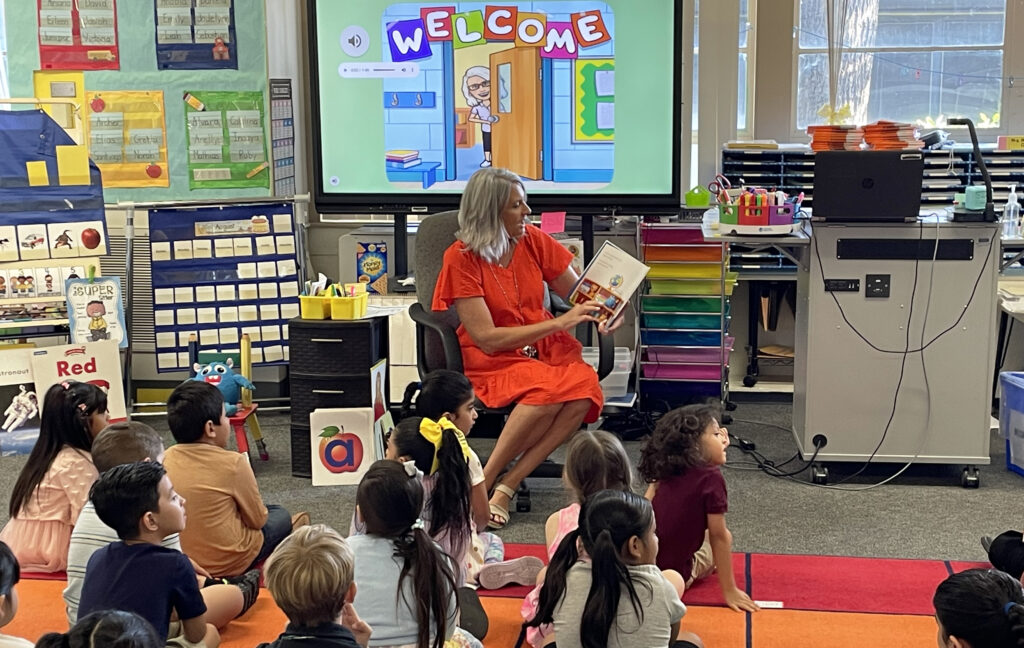
Kindergarten teacher Jana Herrera at Booksin Elementary in San Jose discusses a story written by Casandra Lopez Monsivais.
Liv Ames / EdSource
Believing in the future of California’s most vulnerable students demands an urgent focus on early literacy. Nearly 178,000 economically disadvantaged third graders are not meeting state standards for English language arts, and the vast majority of those falling behind are disproportionately Black and Latino children. Early learning gaps all too often turn into lifelong opportunity gaps. If we as a state are failing to teach a significant number of students from low-income communities to read, then we are failing to be the progressive leaders we profess to be.
According to the latest data from California’s standardized tests, only 3 in 10 third grade students from low-income communities are at grade level in English, compared with 6 in 10 of their higher-income peers. These educational inequities follow a child through to their adult life. Research shows that adults with limited literacy, which includes 28% of Californians, are more likely to be unemployed or earn an income that falls below the poverty level. According to the World Literacy Foundation, illiteracy can also lead to poor health, disenfranchisement and even crime. Among youth involved in the juvenile justice system, up to 85% are functionally illiterate.
This is not just an education issue, it’s a social justice issue.
There are a number of factors, both in and outside the classroom, that have contributed to this achievement gap. We are calling on the state Legislature to address those within their control, which include a combination of the public school system not prioritizing academic outcomes for low-income students enough, no requirements for school districts to teach reading based on evidence-backed practices, a lack of accountability to ensure statewide reading efforts are being implemented with fidelity, and an outdated state-approved instructional materials list.
We now know so much more about how to effectively teach children to read than we have in the past. A large body of interdisciplinary research known as the science of reading informs us of the methods proven most effective in ensuring elementary students develop strong literacy skills. A focus on language development and building background knowledge along with direct and systematic teaching of phonics, word recognition, fluency, and other critical foundational skills benefits students, including English learners.
In recent years, one-third of states have committed to implementing comprehensive literacy policies grounded in the science of reading with encouraging signs of success. Mississippi, one of the leaders in comprehensive research-based literacy reform, went from being ranked 49th in the country in 2013 for fourth grade reading to 21st in 2022, and has made steady progress in reading scores for Black and Latino students and students from low-income communities.
The science of reading is not a panacea for all student reading challenges. But, based on historical research and positive implementation outcomes, it can dramatically improve the lives of California students, particularly those who are most vulnerable.
Given the urgency of this educational crisis, we implore our elected leaders to pass a comprehensive literacy policy agenda based on the science of reading in 2024 so that all children will have the best chance to become proficient readers by the end of third grade.
Anchor components of the agenda should include:
- All English language arts, English language development and reading instructional materials used in California public schools must adhere to methods supported by research.
- Investments in statewide educator training programs for both the science of reading and implementing evidence-based literacy instruction.
- Additional accountability measures and professional development that will help ensure newly certified teachers are prepared to effectively teach reading based on the principles and practices of the science of reading.
Details of these policy recommendations may be found in the California Early Literacy Coalition’s early literacy policy brief.
If there is one primary responsibility of public elementary schools, it is to teach children how to read so they are set up for future success. It is time that we prioritize unlocking reading potential and future opportunities for all of California’s children.
•••
Megan Potente is co-state director for Decoding Dyslexia CA, a grassroots movement dedicated to improving literacy outcomes for those with dyslexia and all struggling readers.
Marshall Tuck is CEO of EdVoice, a nonprofit organization seeking to change state policy so that children from low-income communities receive high-quality educations.
The opinions expressed in this piece represent those of the authors. EdSource welcomes commentaries representing diverse points of view. If you would like to submit a commentary, please review our guidelines and contact us.









